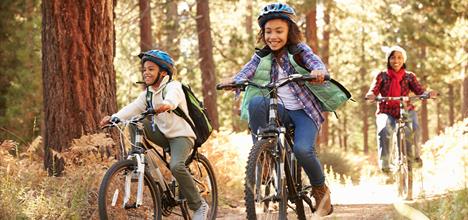
Did you know that only about 1 in 4 children get the recommended 60 minutes of physical activity per day?
Participation in all types of physical activity drops dramatically as a child’s age and grade in school increase. It’s important that physical activity be a regular part of family life. Here is some information to help you keep your children healthy and active.
The benefits of physical activity
Being physically active means moving enough to breathe heavily, be short of breath, feel warm, and sweat. Exercise is vital to the health and well-being of children. Physical activity helps build and maintains healthy bones, muscles, and joints, for example. It can help keep a healthy body mass index and reduce the risk of diabetes, high blood pressure, and heart disease later in life. It can help children fall asleep quickly and sleep well.
Beyond benefits to the body, physical activity also boosts a child’s mental and behavioral health. It increases a child’s enthusiasm and optimism and boosts self-esteem, school performance, attention and behavior. It also reduces anxiety, tension and depression. It can also fosters teamwork and friendship when it’s part of an organized sport.
11 ways to get started
Parents can play a key role in helping their child become more physically active. Some suggestions:
- Talk with your child’s doctor. Your child’s doctor can help your child understand why physical activity is important. Your child’s doctor can also help you and your child identify sports or activities that may be best for your child.
- Emphasize fun. Help your child find a sport that she enjoys. The more she enjoys the activity, the more likely she will be to continue it. Get the entire family involved. It is a great way to spend time together.
- Choose an activity that is developmentally appropriate. For example, a 7- or 8-year-old child is not ready for weight lifting or a 3-mile run, but soccer, bicycle riding, and swimming are all well great activities for kids this age.
- Plan ahead. Make sure your child has a convenient time and place to exercise.
- Provide a safe environment. Make sure your child’s equipment and where they practice or play is safe. Make sure your child’s clothing is comfortable and appropriate for the activity.
- Provide active toys. Young children especially need easy access to balls, jump ropes, and other active toys.
- Be a role model. Children who regularly see their parents enjoying sports and physical activity are more likely to do so themselves.
- Play with your children. Help them learn a new sport or another physical activity. Or just have fun together by going for a walk, hike, or bike ride.
- Set limits. Limit screen time, including time spent on TV, videos, computers, and video games, each day. Use the free time for more physical activities.
- Make time for exercise. Some children are so overscheduled with homework, music lessons, and other planned activities that they do not have time for exercise.
- Do not overdo activity. Exercise and physical activity should not hurt. If it becomes painful, your child should slow down or try a less vigorous activity. As with any activity, it is important not to overdo it. If exercise starts to interfere with school or other activities, talk with your child’s doctor.
Healthy, active living
During well-child visits (also known as health supervision visits), your child’s doctor will ask you questions related to nutrition, fitness, and media habits. Remember that health is not about a specific weight, shape, or size. All children, regardless of their weight, shape, or size, are encouraged to live healthy, active lives.
To lead a healthy, active life, families can strive to reach the following goals:
- Eat at least 5 servings of fruits and vegetables each day.
- Create a Family Media Use Plan to help balance online and off-line activities.
- Children and adolescents aged 6 and older need at least 60 minutes of physical activity every day, as well as at least a few days per week of bone- and muscle-strengthening exercises. Children younger than 6 years need 3 hours of activity every day. Get 1 hour or more of moderate to vigorous physical activity each day.
- Avoid sugary drinks. Choose water or milk for healthy hydration.
Getting the entire family moving
Studies have found that lifestyles learned in childhood are much likelier to stay with a person into adulthood. If sports and physical activities are a family priority, they will provide children and parents with a strong foundation for a lifetime of health.
Remember
Exercise along with a balanced diet provides the foundation for a healthy, active life. One of the most important things parents can do is encourage healthy habits in their children early in life. It is not too late to start. Ask your child’s doctor about tools for healthy living today.
Original Source: https://www.healthychildren.org/English/healthy-living/fitness/Pages/Encouraging-Your-Child-to-be-Physically-Active.aspx